Engage NY Eureka Math 1st Grade Module 2 Lesson 20 Answer Key
Eureka Math Grade 1 Module 2 Lesson 20 Sprint Answer Key
A
*Write the missing number. Pay attention to the addition or subtraction sign.
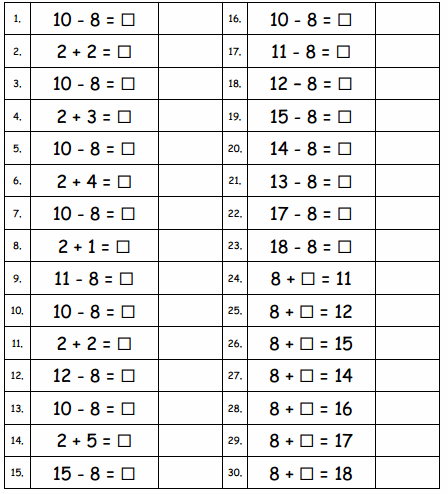
Answer:
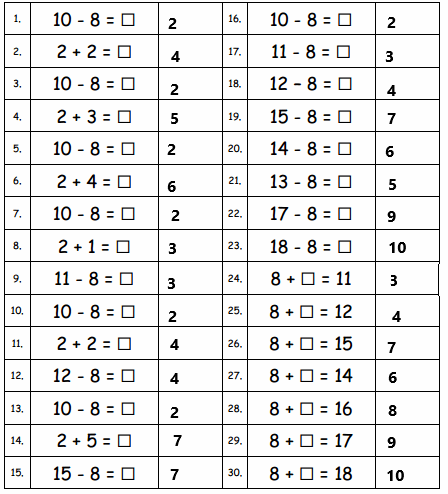
Question 1.
10 – 8 = ☐
Answer:
10 – 8 = 2
Explanation:
Subtraction is an arithmetic operation that represents the operation of removing objects from a collection. The result of a subtraction is called a difference. Subtract eight from ten then we got two.
Question 2.
2 + 2 = ☐
Answer:
2 + 2 = 4
Explanation:
An addition sentence is a mathematical expression that shows two or more values added together. ADD two with two then we got four.
Question 3..
10 – 8 = ☐
Answer:
10 – 8 = 2
Explanation:
Subtraction is an arithmetic operation that represents the operation of removing objects from a collection. The result of a subtraction is called a difference. Subtract eight from ten then we got two.
Question 4.
2 + 3 = ☐
Answer:
2 + 3 = 5
Explanation:
An addition sentence is a mathematical expression that shows two or more values added together. ADD two with three then we got five.
Question 5.
10 – 8 = ☐
Answer:
10 – 8 = 2
Explanation:
Subtraction is an arithmetic operation that represents the operation of removing objects from a collection. The result of a subtraction is called a difference. Subtract eight from ten then we got two.
Question 6.
2 + 4 = ☐
Answer:
2 + 4 = 6
Explanation:
An addition sentence is a mathematical expression that shows two or more values added together. ADD two with four then we got six.
Question 7.
10 – 8 = ☐
Answer:
10 – 8 = 2
Explanation:
Subtraction is an arithmetic operation that represents the operation of removing objects from a collection. The result of a subtraction is called a difference. Subtract eight from ten then we got two.
Question 8.
2 + 1 = ☐
Answer:
2 + 1 = 3
Explanation:
An addition sentence is a mathematical expression that shows two or more values added together. ADD two with one then we got three.
Question 9.
11 – 8 = ☐
Answer:
11 – 8 = 3
Explanation:
Subtraction is an arithmetic operation that represents the operation of removing objects from a collection. The result of a subtraction is called a difference. Subtract eight from eleven then we got three.
Question 10.
10 – 8 = ☐
Answer:
10 – 8 = 2
Explanation:
Subtraction is an arithmetic operation that represents the operation of removing objects from a collection. The result of a subtraction is called a difference. Subtract eight from ten then we got two.
Question 11.
2 + 2 = ☐
Answer:
2 + 2 = 4
Explanation:
An addition sentence is a mathematical expression that shows two or more values added together. ADD two with two then we got four.
Question 12.
12 – 8 = ☐
Answer:
12 – 8 = 4
Explanation:
Subtraction is an arithmetic operation that represents the operation of removing objects from a collection. The result of a subtraction is called a difference. Subtract eight from twelve then we got four.
Question 13.
10 – 8 = ☐
Answer:
10 – 8 = 2
Explanation:
Subtraction is an arithmetic operation that represents the operation of removing objects from a collection. The result of a subtraction is called a difference. Subtract eight from ten then we got two.
Question 14.
2 + 5 = ☐
Answer:
2 + 5 = 7
Explanation:
An addition sentence is a mathematical expression that shows two or more values added together. ADD two with five then we got seven.
Question 15.
15 – 8 = ☐
Answer:
15 – 8 = 7
Explanation:
Subtraction is an arithmetic operation that represents the operation of removing objects from a collection. The result of a subtraction is called a difference. Subtract eight from fifteen then we got seven.
Question 16.
10 – 8 = ☐
Answer:
10 – 8 = 2
Explanation:
Subtraction is an arithmetic operation that represents the operation of removing objects from a collection. The result of a subtraction is called a difference. Subtract eight from ten then we got two.
Question 17.
11 – 8 = ☐
Answer:
11 – 8 = 3
Explanation:
Subtraction is an arithmetic operation that represents the operation of removing objects from a collection. The result of a subtraction is called a difference. Subtract eight from eleven then we got three.
Question 18.
12 – 8 = ☐
Answer:
12 – 8 = 4
Explanation:
Subtraction is an arithmetic operation that represents the operation of removing objects from a collection. The result of a subtraction is called a difference. Subtract eight from twelve then we got four.
Question 19.
15 – 8 = ☐
Answer:
15 – 8 = 7
Explanation:
Subtraction is an arithmetic operation that represents the operation of removing objects from a collection. The result of a subtraction is called a difference. Subtract eight from fifteen then we got seven.
Question 20.
14 – 8 = ☐
Answer:
14 – 8 = 6
Explanation:
Subtraction is an arithmetic operation that represents the operation of removing objects from a collection. The result of a subtraction is called a difference. Subtract eight from fourteen then we got six.
Question 21.
13 – 8 = ☐
Answer:
13 – 8 = 5
Explanation:
Subtraction is an arithmetic operation that represents the operation of removing objects from a collection. The result of a subtraction is called a difference. Subtract eight from thirteen then we got five.
Question 22.
17 – 8 = ☐
Answer:
17 – 8 = 9
Explanation:
Subtraction is an arithmetic operation that represents the operation of removing objects from a collection. The result of a subtraction is called a difference. Subtract eight from seventeen then we got nine.
Question 23.
18 – 8 = ☐
Answer:
18 – 8 = 10
Explanation:
Subtraction is an arithmetic operation that represents the operation of removing objects from a collection. The result of a subtraction is called a difference. Subtract eight from eighteen then we got ten.
Question 24.
8 + ☐ = 11
Answer:
8 + 3 = 11
Explanation:
An addition sentence is a mathematical expression that shows two or more values added together. ADD eight with three then we got eleven.
Question 25.
8 + ☐ = 12
Answer:
8 + 4 = 12
Explanation:
An addition sentence is a mathematical expression that shows two or more values added together. ADD eight with four then we got twelve.
Question 26.
8 + ☐ = 15
Answer:
8 + 7 = 15
Explanation:
An addition sentence is a mathematical expression that shows two or more values added together. ADD eight with seven then we got fifteen.
Question 27.
8 + ☐ = 14
Answer:
8 + 6 = 14
Explanation:
An addition sentence is a mathematical expression that shows two or more values added together. ADD eight with six then we got fourteen.
Question 28.
8 + ☐ = 16
Answer:
8 + 8 = 16
Explanation:
An addition sentence is a mathematical expression that shows two or more values added together. ADD eight with eight then we got sixteen.
Question 29.
8 + ☐ = 17
Answer:
8 + 9 = 17
Explanation:
An addition sentence is a mathematical expression that shows two or more values added together. ADD eight with nine then we got seventeen.
Question 30.
8 + ☐ = 18
Answer:
8 + 10 = 18
Explanation:
An addition sentence is a mathematical expression that shows two or more values added together. ADD eight with ten then we got eighteen.
B
*Write the missing number. Pay attention to the addition or subtraction sign.
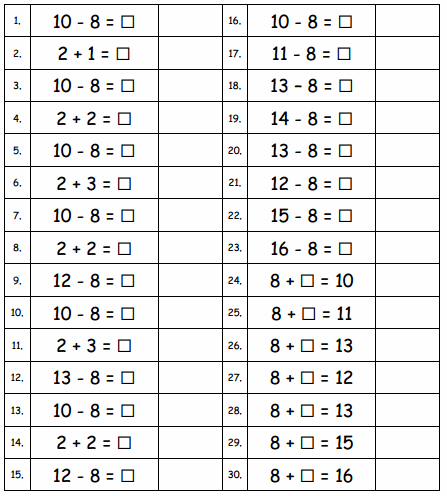
Answer:
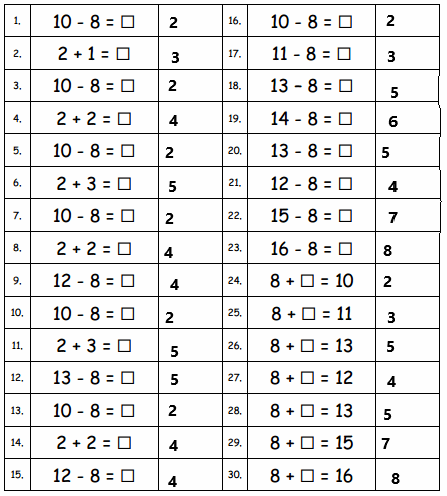
Question 1.
10 – 8 = ☐
Answer:
10 – 8 = 2
Explanation:
Subtraction is an arithmetic operation that represents the operation of removing objects from a collection. The result of a subtraction is called a difference. Subtract eight from ten then we got two.
Question 2.
2 + 1 = ☐
Answer:
An addition sentence is a mathematical expression that shows two or more values added together. ADD two with one then we got three.
Question 3.
10 – 8 = ☐
Answer:
10 – 8 = 2
Explanation:
Subtraction is an arithmetic operation that represents the operation of removing objects from a collection. The result of a subtraction is called a difference. Subtract eight from ten then we got two.
Question 4.
2 + 2 = ☐
Answer:
2 + 2= 4
Explanation:
An addition sentence is a mathematical expression that shows two or more values added together. ADD two with two then we got four.
Question 5.
10 – 8 = ☐
Answer:
10 – 8 = 2
Explanation:
Subtraction is an arithmetic operation that represents the operation of removing objects from a collection. The result of a subtraction is called a difference. Subtract eight from ten then we got two.
Question 6.
2 + 3 = ☐
Answer:
An addition sentence is a mathematical expression that shows two or more values added together. ADD two with three then we got five.
Question 7.
10 – 8 = ☐
Answer:
10 – 8 = 2
Explanation:
Subtraction is an arithmetic operation that represents the operation of removing objects from a collection. The result of a subtraction is called a difference. Subtract eight from ten then we got two.
Question 8.
2 + 2 = ☐
Answer:
2 + 2 = 4
Explanation:
An addition sentence is a mathematical expression that shows two or more values added together. ADD two with two then we got four.
Question 9.
12 – 8 = ☐
Answer:
12 – 8 = 4
Explanation:
Subtraction is an arithmetic operation that represents the operation of removing objects from a collection. The result of a subtraction is called a difference. Subtract eight from twelve then we got four.
Question 10.
10 – 8 = ☐
Answer:
10 – 8 = 2
Explanation:
Subtraction is an arithmetic operation that represents the operation of removing objects from a collection. The result of a subtraction is called a difference. Subtract eight from ten then we got two.
Question 11.
2 + 3 = ☐
Answer:
2 + 3 = 5
Explanation:
An addition sentence is a mathematical expression that shows two or more values added together. ADD two with three then we got five.
Question 12.
13 – 8 = ☐
Answer:
13 – 8 = 5
Explanation:
Subtraction is an arithmetic operation that represents the operation of removing objects from a collection. The result of a subtraction is called a difference. Subtract eight from thirteen then we got five.
Question 13.
10 – 8 = ☐
Answer:
10 – 8 = 2
Explanation:
Subtraction is an arithmetic operation that represents the operation of removing objects from a collection. The result of a subtraction is called a difference. Subtract eight from ten then we got two.
Question 14.
2 + 2 = ☐
Answer:
2 + 2 = 4
Explanation:
An addition sentence is a mathematical expression that shows two or more values added together. ADD two with two then we got four.
Question 15.
12 – 8 = ☐
Answer:
12 – 8 = 4
Explanation:
Subtraction is an arithmetic operation that represents the operation of removing objects from a collection. The result of a subtraction is called a difference. Subtract eight from twelve then we got four.
Question 16.
10 – 8 = ☐
Answer:
10 – 8 = 2
Explanation:
Subtraction is an arithmetic operation that represents the operation of removing objects from a collection. The result of a subtraction is called a difference. Subtract eight from ten then we got two.
Question 17.
11 – 8 = ☐
Answer:
11 – 8 = 3
Explanation:
Subtraction is an arithmetic operation that represents the operation of removing objects from a collection. The result of a subtraction is called a difference. Subtract eight from eleven then we got three.
Question 18.
13 – 8 = ☐
Answer:
13 – 8 = 5
Explanation:
Subtraction is an arithmetic operation that represents the operation of removing objects from a collection. The result of a subtraction is called a difference. Subtract eight from thirteen then we got five.
Question 19.
14 – 8 = ☐
Answer:
14 – 8 = 6
Explanation:
Subtraction is an arithmetic operation that represents the operation of removing objects from a collection. The result of a subtraction is called a difference. Subtract eight from fourteen then we got six.
Question 20.
13 – 8 = ☐
Answer:
13 – 8 = 5
Explanation:
Subtraction is an arithmetic operation that represents the operation of removing objects from a collection. The result of a subtraction is called a difference. Subtract eight from thirteen then we got five.
Question 21.
12 – 8 = ☐
Answer:
12 – 8 = 4
Explanation:
Subtraction is an arithmetic operation that represents the operation of removing objects from a collection. The result of a subtraction is called a difference. Subtract eight from twelve then we got four.
Question 22.
15 – 8 = ☐
Answer:
15 – 8 = 7
Explanation:
Subtraction is an arithmetic operation that represents the operation of removing objects from a collection. The result of a subtraction is called a difference. Subtract eight from fifteen then we got seven.
Question 23.
16 – 8 = ☐
Answer:
16 – 8 = 8
Explanation:
Subtraction is an arithmetic operation that represents the operation of removing objects from a collection. The result of a subtraction is called a difference. Subtract eight from sixteen then we got eight.
Question 24.
8 + ☐ = 10
Answer:
8 + 2 = 10
Explanation:
An addition sentence is a mathematical expression that shows two or more values added together. ADD eight with two then we got ten.
Question 25.
8 + ☐ = 11
Answer:
8 + 3 = 11
Explanation:
An addition sentence is a mathematical expression that shows two or more values added together. ADD eight with three then we got eleven.
Question 26.
8 + ☐ = 13
Answer:
8 + 5 = 13
Explanation:
An addition sentence is a mathematical expression that shows two or more values added together. ADD eight with five then we got thirteen.
Question 27.
8 + ☐ = 12
Answer:
8 + 4 = 12
Explanation:
An addition sentence is a mathematical expression that shows two or more values added together. ADD eight with four then we got twelve.
Question 28.
8 + ☐ = 13
Answer:
8 + 5 = 13
Explanation:
An addition sentence is a mathematical expression that shows two or more values added together. ADD eight with five then we got thirteen.
Question 29.
8 + ☐ = 15
Answer:
8 + 7 = 15
Explanation:
An addition sentence is a mathematical expression that shows two or more values added together. ADD eight with seven then we got fifteen.
Question 30.
8 + ☐ = 16
Answer:
8 + 8 = 16
Explanation:
An addition sentence is a mathematical expression that shows two or more values added together. ADD eight with eight then we got sixteen.
Eureka Math Grade 1 Module 2 Lesson 20 Problem Set Answer Key
Solve the problems below. Use drawings or number bonds.
Question 1.
11 – 9 = __
Answer:
11 – 9 = 2
10 – 9 = 1
1 + 1 = 2

Explanation:
In the above image we can observe a number sentence 11 – 9 = 2. Draw a 5- group rows. Break eleven into ten and one. First make a frame for ten then take nine from the ten. It’s called the take from ten strategy. Cross out nine circles in the frame. Then one circle in the frame and one circle on other side make two.
Question 2.
11 – 8 = __
Answer:
11 – 8 = 3
10 – 8 = 2
2 + 1 = 3

Explanation:
In the above image we can observe a number sentence 11 – 8 = 3. Draw a 5- group rows. Break eleven into ten and one. First make a frame for ten then take eight from the ten. It’s called the take from ten strategy. Cross out eight circles in the frame. Then two circles in the frame and one circle on other side make three.
Question 3.
13 – 9 = __
Answer:

Explanation:
A number bond is a simple addition of two numbers that add up to give the sum. In the above image we can observe a number sentence 13 – 9 = 4. Break thirteen into two parts as ten and three. Subtract nine from ten then we got one. ADD one with three then we got four.
Question 4.
13 – 8 = __
Answer:

Explanation:
A number bond is a simple addition of two numbers that add up to give the sum. In the above image we can observe a number sentence 13 – 8 = 5. Break thirteen into two parts as ten and three. Subtract eight from ten then we got two. ADD two with three then we got five.
Question 5.
13 – 7 = ___
Answer:
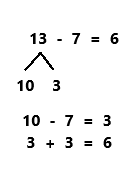
Explanation:
A number bond is a simple addition of two numbers that add up to give the sum. In the above image we can observe a number sentence 13 – 7 = 6. Break thirteen into two parts as ten and three. Subtract seven from ten then we got three. ADD three with three then we got six.
Question 6.
12 – 7 = __
Answer:

Explanation:
A number bond is a simple addition of two numbers that add up to give the sum. In the above image we can observe a number sentence 12 – 7 = 5. Break twelve into two parts as ten and two. Subtract seven from ten then we got three. ADD three with two then we got five.
Question 7.
Match the equal expressions.

Answer:

Explanation:
a. In the above image we can observe 16 – 7. Break sixteen into two parts as ten and six. Subtract seven from ten then we got three. ADD three with six then we got nine. In the above image we can observe 18 – 9 expression on the right side. Break eighteen into two parts as ten and eight. Subtract nine from ten then we got one. ADD one with eight then we got nine. The equal expression for 16 – 7 is 18 – 9.
b. In the above image we can observe 17 – 7. Break seventeen into two parts as ten and seven. Subtract seven from ten then we got three. ADD three with seven then we got ten. In the above image we can observe 18 – 8 expression on the right side. Break eighteen into two parts as ten and eight. Subtract eight from ten then we got two. ADD two with eight then we got ten. The equal expression for 17 – 7 is 18 – 8.
c. In the above image we can observe 12 – 8. Break twelve into two parts as ten and two. Subtract eight from ten then we got two. ADD two with two then we got four. In the above image we can observe 13 – 9 expression on the right side. Break thirteen into two parts as ten and three. Subtract nine from ten then we got one. ADD one with three then we got four. The equal expression for 12 – 8 is 13 – 9.
d. In the above image we can observe 14 – 8. Break fourteen into two parts as ten and four. Subtract eight from ten then we got two. ADD two with four then we got six. In the above image we can observe 15 – 9 expression on the right side. Break fifteen into two parts as ten and five. Subtract nine from ten then we got one. ADD one with five then we got six. The equal expression for 14 – 8 is 15 – 9.
Complete the subtraction sentences to make them true.
Question 8.
a.
12 – 9 = __
Answer:
12 – 9 = 3
Explanation:
In the above answer we can observe a number sentence 12 – 9 = 3. Break twelve into two parts as ten and two. Subtract nine from ten then we got one. ADD one with two then we got three.
b.
13 – 9 = __
Answer:
13 – 9 = 4
Explanation:
In the above answer we can observe a number sentence 13 – 9 = 4. Break thirteen into two parts as ten and three. Subtract nine from ten then we got one. ADD one with three then we got four.
c.
14 – 9 = __
Answer:
14 – 9 = 5
Explanation:
In the above answer we can observe a number sentence 14 – 9 = 5. Break fourteen into two parts as ten and four. Subtract nine from ten then we got one. ADD one with four then we got five.
Question 9.
a.
12 – 8 = __
Answer:
12 – 8 = 4
Explanation:
In the above answer we can observe a number sentence 12 – 8 = 4. Break twelve into two parts as ten and two. Subtract eight from ten then we got two. ADD two with two then we got four.
b.
13 – 8 = __
Answer:
13 – 8 = 5
Explanation:
In the above answer we can observe a number sentence 13 – 8 = 5. Break thirteen into two parts as ten and three. Subtract eight from ten then we got two. ADD two with three then we got five.
c.
14 – 8 = __
Answer:
14 – 8 = 6
Explanation:
In the above answer we can observe a number sentence 14 – 8 = 6. Break fourteen into two parts as ten and four. Subtract eight from ten then we got two. ADD two with four then we got six.
Question 10.
a.
11 – 7 = __
Answer:
11 – 7 = 4
Explanation:
In the above answer we can observe a number sentence 11 – 7 = 4. Break eleven into two parts as ten and one. Subtract seven from ten then we got three. ADD three with one then we got four.
b.
12 – 7 = __
Answer:
12 – 7 = 5
Explanation:
In the above answer we can observe a number sentence 12 – 7 = 5. Break twelve into two parts as ten and two. Subtract seven from ten then we got three. ADD three with two then we got five.
c.
13 – 7 = __
Answer:
13 – 7 = 6
Explanation:
In the above answer we can observe a number sentence 13 – 7 = 6. Break thirteen into two parts as ten and three. Subtract seven from ten then we got three. ADD three with three then we got six.
Question 11.
a.
16 – 9 = __
Answer:
16 – 9 = 7
Explanation:
In the above answer we can observe a number sentence 16 – 9 = 7. Break sixteen into two parts as ten and six. Subtract nine from ten then we got one. ADD one with six then we got seven.
b.
18 – 9 = ___
Answer:
18 – 9 = 9
Explanation:
In the above answer we can observe a number sentence 18 – 9 = 9. Break eighteen into two parts as ten and eight. Subtract nine from ten then we got one. ADD one with eight then we got nine.
c.
17 – 9 = __
Answer:
17 – 9 = 8
Explanation:
In the above answer we can observe a number sentence 17 – 9 = 8. Break seventeen into two parts as ten and seven. Subtract nine from ten then we got one. ADD one with seven then we got eight.
Question 12.
a.
16 – __ = 9
Answer:
16 – 7 = 9
Explanation:
In the above answer we can observe a number sentence 16- 7 = 9. Break sixteen into two parts as ten and six. Subtract seven from ten then we got three. ADD three with six then we got nine.
b.
15 – __ = 9
Answer:
15 – 6 = 9
Explanation:
In the above answer we can observe a number sentence 15 – 6 = 9. Break fifteen into two parts as ten and five. Subtract six from ten then we got four. ADD four with five then we got nine.
c.
15 – __ = 7
Answer:
15 – 8 = 7
Explanation:
In the above answer we can observe a number sentence 15 – 8 = 7. Break fifteen into two parts as ten and five. Subtract eight from ten then we got two. ADD two with five then we got seven.
Question 13.
a.
15 – __ = 6
Answer:
15 – 9 = 6
Explanation:
In the above answer we can observe a number sentence 15 – 9 = 6. Break fifteen into two parts as ten and five. Subtract nine from ten then we got one. ADD one with five then we got six.
b.
11 – __ = 3
Answer:
11 – 8 = 3
Explanation:
In the above answer we can observe a number sentence 11 – 8 = 3. Break eleven into two parts as ten and one. Subtract eight from ten then we got two. ADD two with one then we got three.
c.
16 – __ = 7
Answer:
16 – 9 = 7
Explanation:
In the above answer we can observe a number sentence 16 – 9 = 7. Break sixteen into two parts as ten and six. Subtract nine from ten then we got one. ADD one with six then we got seven.
Eureka Math Grade 1 Module 2 Lesson 20 Exit Ticket Answer Key
Solve the problems below. Use drawings or number bonds.
a. 14 – 9 = __
Answer:
14 – 9 = 5
10 – 9 = 1
1 + 4 = 5

Explanation:
In the above image we can observe a number sentence 14 – 9 = 5. Draw a 5- group rows. Break fourteen into ten and four. First make a frame for ten then take nine from the ten. It’s called the take from ten strategy. Cross out nine circles in the frame. Then one circle in the frame and four circles on other side make five.
b. 14 – 7 = __
Answer:
14 – 7 = 7
10 – 7 = 3
3 + 4 = 7

Explanation:
In the above image we can observe a number sentence 14 – 7 = 7. Draw a 5- group rows. Break fourteen into ten and four. First make a frame for ten then take seven from the ten. It’s called the take from ten strategy. Cross out seven circles in the frame. Then three circles in the frame and four circles on other side make seven.
c. 14 – 8 = __
Answer:
14 – 8 = 6
10 – 8 = 2
2 + 4 = 6

Explanation:
In the above image we can observe a number sentence 14 – 8 = 6. Draw a 5- group rows. Break fourteen into ten and four. First make a frame for ten then take eight from the ten. It’s called the take from ten strategy. Cross out eight circles in the frame. Then two circles in the frame and four circles on other side make six.
d. 16 – 7 = __
Answer:
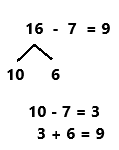
Explanation:
A number bond is a simple addition of two numbers that add up to give the sum. In the above image we can observe a number sentence 16 – 7 = 9. Break sixteen into two parts as ten and six. Subtract seven from ten then we got three. ADD three with six then we got nine.
e. 16 – 9 = __
Answer:
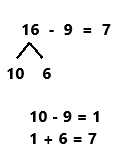
Explanation:
A number bond is a simple addition of two numbers that add up to give the sum. In the above image we can observe a number sentence 16 – 9 = 7. Break sixteen into two parts as ten and six. Subtract nine from ten then we got one. ADD one with six then we got seven.
f. 16 – 8 = __
Answer:

Explanation:
A number bond is a simple addition of two numbers that add up to give the sum. In the above image we can observe a number sentence 16 – 8 = 8. Break sixteen into two parts as ten and six. Subtract eight from ten then we got two. ADD two with six then we got eight.
Eureka Math Grade 1 Module 2 Lesson 20 Homework Answer Key
Complete the number sentences to make them true.
Question 1.
15 – 9 = ____
Answer:
15 – 9 = 6
Explanation:
In the above answer we can observe a number sentence 15 – 9 = 6. Break fifteen into two parts as ten and five. Subtract nine from ten then we got one. ADD one with five then we got six.
Question 2.
15 – 8 = ____
Answer:
15 – 8 = 7
Explanation:
In the above answer we can observe a number sentence 15 – 8 = 7. Break fifteen into two parts as ten and five. Subtract eight from ten then we got two. ADD two with five then we got seven.
Question 3.
15 – 7 = ____
Answer:
15 – 7 = 8
Explanation:
In the above answer we can observe a number sentence 15 – 7 = 8. Break fifteen into two parts as ten and five. Subtract seven from ten then we got three. ADD three with five then we got eight.
Question 4.
17 – 9 = ____
Answer:
17 – 9 = 8
Explanation:
In the above answer we can observe a number sentence 17 – 9 = 8. Break seventeen into two parts as ten and seven. Subtract nine from ten then we got one. ADD one with seven then we got eight.
Question 5.
17 – 8 = ____
Answer:
17 – 8 = 9
Explanation:
In the above answer we can observe a number sentence 17 – 8 = 9. Break seventeen into two parts as ten and seven. Subtract eight from ten then we got two. ADD two with seven then we got nine.
Question 6.
17 – 7 = ____
Answer:
17 – 7 = 10
Explanation:
In the above answer we can observe a number sentence 17 – 7 = 10. Break seventeen into two parts as ten and seven. Subtract seven from ten then we got three. ADD three with seven then we got ten.
Question 7.
16 – 9 = ____
Answer:
16 – 9 = 7
Explanation:
In the above answer we can observe a number sentence 16 – 9 = 7. Break sixteen into two parts as ten and six. Subtract nine from ten then we got one. ADD one with six then we got seven.
Question 8.
16 – 8 = ____
Answer:
16 – 8 = 8
Explanation:
In the above answer we can observe a number sentence 16 – 8 = 8. Break sixteen into two parts as ten and six. Subtract eight from ten then we got two. ADD two with six then we got eight.
Question 9.
16 – 7 = ____
Answer:
16 – 7 = 9
Explanation:
In the above answer we can observe a number sentence 16 – 7 = 9. Break sixteen into two parts as ten and six. Subtract seven from ten then we got three. ADD three with six then we got nine.
Question 10.
19 – 9 = ____
Answer:
19 – 9 = 10
Explanation:
In the above answer we can observe a number sentence 19 – 9 = 10. Break nineteen into two parts as ten and nine. Subtract nine from ten then we got one. ADD one with nine then we got ten.
Question 11.
19 – 8 = ____
Answer:
19 – 8 = 11
Explanation:
In the above answer we can observe a number sentence 19 – 8 = 11. Break nineteen into two parts as ten and nine. Subtract eight from ten then we got two. ADD two with nine then we got eleven.
Question 12.
19 – 7 = ____
Answer:
19 – 7 = 12
Explanation:
In the above answer we can observe a number sentence 19 – 7 = 12. Break nineteen into two parts as ten and nine. Subtract seven from ten then we got three. ADD three with nine then we got twelve.
Question 13.
Match equal expressions.

Answer:

Explanation:
a. In the above image we can observe 19 – 9. Break nineteen into two parts as ten and nine. Subtract nine from ten then we got one. ADD one with nine then we got ten. In the above image we can observe 18 – 8 expression on the right side. Break eighteen into two parts as ten and eight. Subtract eight from ten then we got two. ADD two with eight then we got ten. The equal expression for 19 – 9 is 18 – 8.
b. In the above image we can observe 13 – 8. Break thirteen into two parts as ten and three. Subtract eight from ten then we got two. ADD two with three then we got five. In the above image we can observe 12 – 7 expression on the right side. Break twelve into two parts as ten and two. Subtract seven from ten then we got three. ADD three with two then we got five. The equal expression for 13 – 8 is 12 – 7.
Question 14.
Read the math story. Use a drawing or a number bond to show how you know who is right.
a. Elsie says that the expressions 17 – 8 and 18 – 9 are equal. John says they are not equal. Who is right?
Answer:
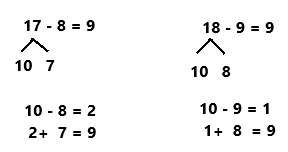
Both expressions are equal. So Elise is right.
Explanation:
Elsie says that the expressions 17 – 8 and 18 – 9 are equal. John says they are not equal. A number bond is a simple addition of two numbers that add up to give the sum. In the above image we can observe a number sentence 17 – 8 = 9. Break seventeen into two parts as ten and seven. Subtract eight from ten then we got two. ADD two with seven then we got nine. In the above image we can observe a another number sentence 18 – 9 = 9. Break eighteen into two parts as ten and eight. Subtract nine from ten then we got one. ADD one with eight then we got nine. Both expressions are equal. So Elise is right.
b. John says that the expressions 11 – 8 and 12 – 8 are not equal. Elsie says they are. Who is right?
Answer:
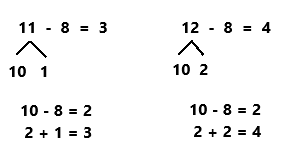
Both expressions are not equal. so John is right.
Explanation:
John says that the expressions 11 – 8 and 12 – 8 are not equal. Elsie says they are equal. A number bond is a simple addition of two numbers that add up to give the sum. In the above image we can observe a number sentence 11 – 8 = 3. Break eleven into two parts as ten and one. Subtract eight from ten then we got two. ADD two with one then we got three. In the above image we can observe a another number sentence 12 – 8 = 4. Break twelve into two parts as ten and two. Subtract eight from ten then we got two. ADD two with two then we got four. Both expressions are not equal. So John is right.
c. Elsie says that to solve 17 – 9, she can take one from 17 and give it to 9 to make 10. So, 17 – 9 is equal to 16 – 10. John thinks Elsie made a mistake. Who is correct?
Answer:

Both are not equal. So John is correct.
Explanation:
Elsie says that to solve 17 – 9, she can take one from 17 and give it to 9 to make 10. So, 17 – 9 is equal to 16 – 10. John thinks Elsie made a mistake. A number bond is a simple addition of two numbers that add up to give the sum. In the above image we can observe a number sentence 17 – 9 = 8. Break seventeen into two parts as ten and seven. Subtract nine from ten then we got one. ADD one with seven then we got eight. In the above image we can observe a another number sentence 16 – 10 = 6. Break sixteen into two parts as ten and six. Subtract ten from ten then we got zero. ADD zero with six then we got six. Both expressions are not equal. So John is correct.
d. John and Elsie are trying to find several subtraction number sentences that start with numbers larger than 10 and have an answer of 7. Help them figure out number sentences. They started the first one.

Answer:

Explanation:
In the above image we can observe a number sentence 16 – 9 = 7. Break sixteen into two parts as ten and six. Subtract nine from ten then we got one. ADD one with six then we got seven.
In the above image we can observe a number sentence 15 – 8 = 7. Break fifteen into two parts as ten and five. Subtract eight from ten then we got two. ADD two with five then we got seven.
In the above image we can observe a number sentence 17 – 10 = 7. Break seventeen into two parts as ten and seven. Subtract ten from ten then we got zero. ADD zero with seven then we got seven.
In the above image we can observe a number sentence 14 – 7 = 7. Break fourteen into two parts as ten and four. Subtract seven from ten then we got three. ADD three with four then we got seven.